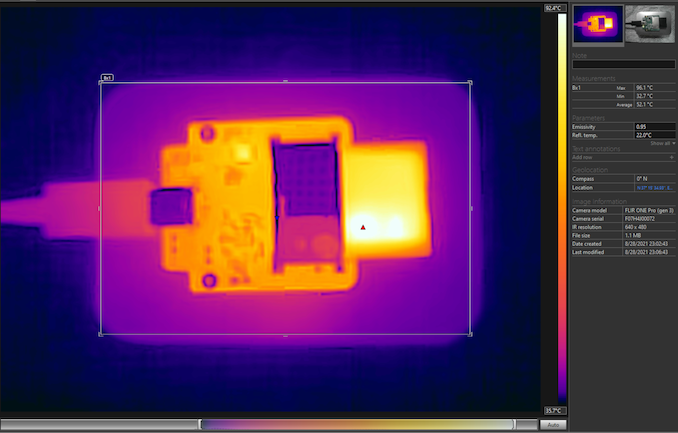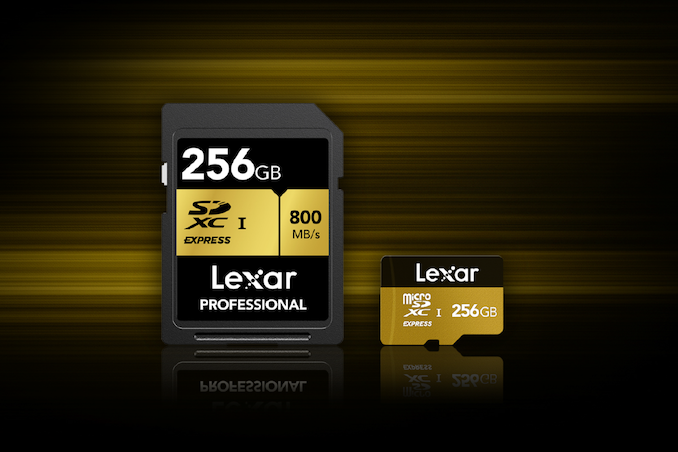Next Gen NVMe SD Card Review: The SM2708 Controller Serves it Hot and Fast
by Ganesh T S on September 9, 2021 9:00 AM EST- Posted in
- Storage
- NAND
- flash
- NVMe
- Silicon Motion
- Memory Cards
- 3D TLC
- SD Express
Miscellaneous Aspects and Concluding Remarks
The appearance of PCIe / NVMe in the memory cards space enables us to bring over some of our direct-attached storage evaluation metrics. Two important aspects are power consumption and thermal characteristics.
Power Consumption
Bus-powered devices can configure themselves to operate within the power delivery constraints of the host port. While Thunderbolt ports are guaranteed to supply up to 15W for client devices, USB 2.0 ports are guaranteed to deliver only 2.5W (500mA @ 5V). In this context, it is interesting to have a fine-grained look at the power consumption profile of the memory card / card reader combination. Using the Plugable USBC-TKEY, the bus power consumption of the drives was tracked while processing the complete test suite. The graphs below plot the instantaneous bus power consumption against time, while singling out the maximum and minimum power consumption numbers.
| Power Consumption Profile [Card + Reader] | |
| TOP: | BOTTOM: |
The Realtek card reader and the SM2708 reference design combination has a peak power consumption of 4.58W, with the average being around 3.25W. On the other hand, in UHS-I mode, the Lexar card reader and the reference design operate at less than 1.67W, with the average being around 1.25W. The extra performance in SD Express mode comes at the cost of power consumption, but that is no surprise.
Thermal Profile
The performance consistency evaluation of the reference design in SD Express mode revealed the internal temperature of the SD card to be around 100C when subject to heavy stress. In order to rule out any errors in the S.M.A.R.T polling, we used a FLIR One Pro thermal imager to capture the thermal profile of the card while being subjected to the performance consistency test.
To our dismay, we found the surface temperature to be as high as 96C - something entirely unsafe for handling with bare hands. It does look like safety standards allow for such surface temperatures, provided the device is under 50mm x 50mm in size. Unfortunately, it is a sad reality that the SD card and microSD card form-factors do not allow for the thermal design necessary to sustain extended operation with NVMe-class speeds. In any case, Silicon Motion's customers can tweak the firmware's configurable parameters to achieve a different balance between performance and temperature. The SM2708 might also held back a bit by its 28nm fabrication node. Once SD Express achieves scale of deployment, it is likely that Silicon Motion can choose more advanced nodes to drive down the power consumption and stress temperatures.
Final Words
Reviewing the Silicon Motion SM2708 reference design has helped us greatly in setting the consumer expectations for SD Express using NVMe right. The advertised numbers can only be achieved in burst mode, and sustained writes may be affected by a combination of SLC cache sizes and thermals. Performance similar to that of a high-end SATA SSD or a PCIe 3.0 x2 NVMe SSD can be expected, though the nature and number of flash pieces inside the card can heavily influence the performance.
Silicon Motion has a couple of design wins ready to ship, with ADATA and Lexar in the final stages of bringing their SD Express products into the market.
Overall, consumers have been waiting for SD Express for quite some time. While CFexpress has taken the early lead with camera / camcorder makers, SD cards have a much wider range of markets to service and target. We are bullish on the prospects for SD Express in verticals such as portable game consoles and SBCs, but it might take a few years for mid-range cameras to start supporting it.
In the meanwhile, products such as the Silicon Motion SM2708 and Realtek RTL9211DS / RTS5261 can prime the market for the new standard on the PC side. A lot is dependent on the vendors not charging too much of a premium for SD Express over the standard UHS-II cards / readers.














43 Comments
View All Comments
eastcoast_pete - Thursday, September 9, 2021 - link
Those temperatures and power draws are way too high for what is probably the main use scenario: removable storage in high-resolution handheld cameras. They're also too high for potential use as removable storage, again mainly for video, in future Smartphones, once Android counterparts to Apple's upcoming iPhone Pro Max become available. That can reportedly use ProRes as file format to save videos, and ProRes eats storage space for breakfast.bananaforscale - Thursday, September 9, 2021 - link
Temps are certainly too high, but power draw not necessarily. That peak draw of 4.58W is ~1.1A at 4.2V, so you could power one off a single 18650 cell for a couple of hours assuming peak is constant, which it won't be.Fulljack - Thursday, September 9, 2021 - link
I think it's more intended for state-of-the-art digital camera that output high bitrate, high resolution video. one of the limiting factor are storage speed. having this on what seems like a laptop on your shoulders would help portability a lot.at_clucks - Friday, September 10, 2021 - link
At that point many users simply invest in cameras that output to an external SSD, at least with something like a CFast to SSD adapter.schuckles - Friday, September 10, 2021 - link
Whether these cards are usable as is really depends on your workload. I would have liked to see something like the anadrech light benchmarked and include the MBPS/watt to know how realistic that 4 watt workload is. Also curious what the idle/standby power of the card itself is.PaulHoule - Thursday, September 9, 2021 - link
How much heat could you remove from that kind of thing if you made the exterior out of metal and pressed it between two cold plates with a strong spring? I'd like to give an SDExpress card the same treatment as the "CPU" on an IBM 3090.shelbystripes - Thursday, September 9, 2021 - link
So… CFExpress cards are stupid fast, but get hot just doing sustained read (copying a full 256GB card’s contents to a computer all at once). And this is putting the same thing in an even smaller form factor. Of course the end result is inevitable.For photography this is still valuable, the cards are fast enough even in UHS-I mode for sustained burst in most cameras, and then having PCIe speeds for clearing the contents quickly to a PC is quite handy. But for video… these things will get hot, and compact camera thermals are already a nightmare. The Canon EOS R5 can technically shoot 8K video, but do it for very long and the damn thing overheats. The more you add awful thermal properties inside a compact environment like that, the worse off you are…
spaceship9876 - Thursday, September 9, 2021 - link
you forgot to mention ufs cards.Einy0 - Thursday, September 9, 2021 - link
Wow, 96C that will leave a mark!Kamen Rider Blade - Thursday, September 9, 2021 - link
When are regular sized SD cards going to go up in size?1TB Micro SD Cards already exists.
I calculate that if you make optimal use of the physical space of a SD card, you can get 4.5 TiB of storage using existing 512 GiB Nand Flash cells.
Wouldn't you want an entire regular sized SD card with 4.5 TiB of storage?